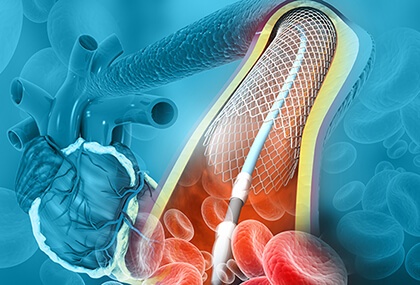Drug-eluting balloons have demonstrated safety and effectiveness in the treatment of small-vessel coronary artery disease and in-stent restenosis. However, randomized studies were performed using paclitaxel.

Several studies have shown that using biolimus, a semisynthetic analog of sirolimus, optimizes drug delivery in both stents and balloons.
The aim of this randomized, multicenter study was to evaluate the safety and effectiveness of the biolimus-coated balloon (BCB) in patients with small-vessel coronary artery disease (reference vessel diameter 2.0 to 2.75 mm and length ≤25 mm) undergoing coronary angioplasty.
The primary endpoint (PEP) was vessel lumen narrowing at 9 months as measured by angiography. The secondary endpoint (SEP) included restenosis, and procedural, lesion, and device success.
Clinical outcomes were evaluated up to a 1-year follow-up and included cardiovascular death, treated-vessel-related acute myocardial infarction, clinically guided revascularization, and treated-vessel failure, among others.
A total of 212 patients were included and randomized as follows: 106 to the BCB group and 103 to the balloon angioplasty group; the remaining 3 were excluded because they did not receive the device.
Read also: Should We Start Thinking Again About Bioresorbable Stents?
Mean patient age was 61 years old, and 30% of subjects were female. The most frequent clinical presentation was unstable angina. The number of lesions treated in >95% of patients was 1. Pre-dilation was achieved in all cases and the number of pre-dilations in most patients was 1.
For the PEP, BCB was superior to balloon angioplasty (p = 0.001). The restenosis rate was lower in the BCB group, with 9.9% vs. 28% in the balloon group (p = 0.001). There were no differences in the SEP nor in clinical events at 1 year.
Conclusion
This randomized study has demonstrated the safety and efficacy of the new biolimus-coated balloon in patients with small-vessel coronary artery disease. Positive vascular remodeling was 3 times more frequent when using these devices, and there was a non-significant trend in clinical improvement at 1 year.

Dr. Andrés Rodríguez
Member of the Editorial Board of SOLACI.org.
Original Title: Biolimus-Coated Balloon in Small-Vessel Coronary Artery Disease The BIO-RISE CHINA Study.
Reference: Kai Xu, MD et al J Am Coll Cardiol Intv 2022.
Subscribe to our weekly newsletter
Get the latest scientific articles on interventional cardiology





